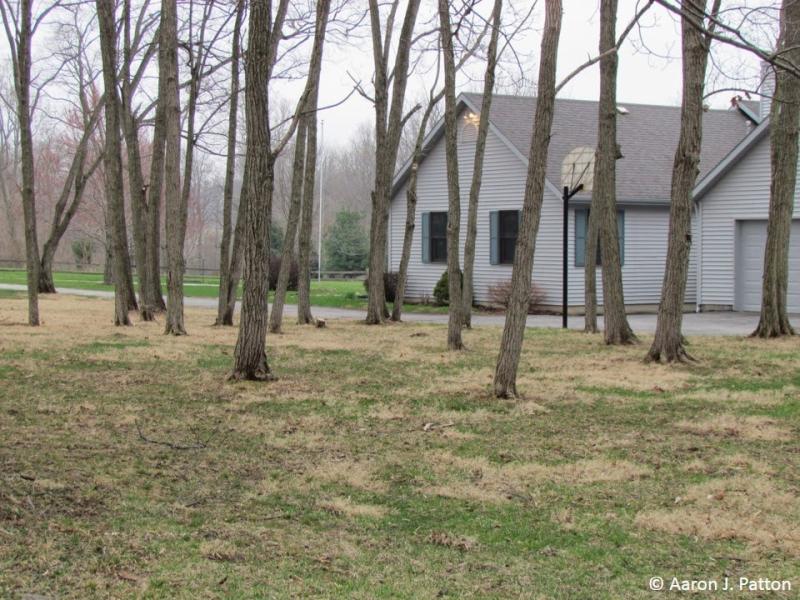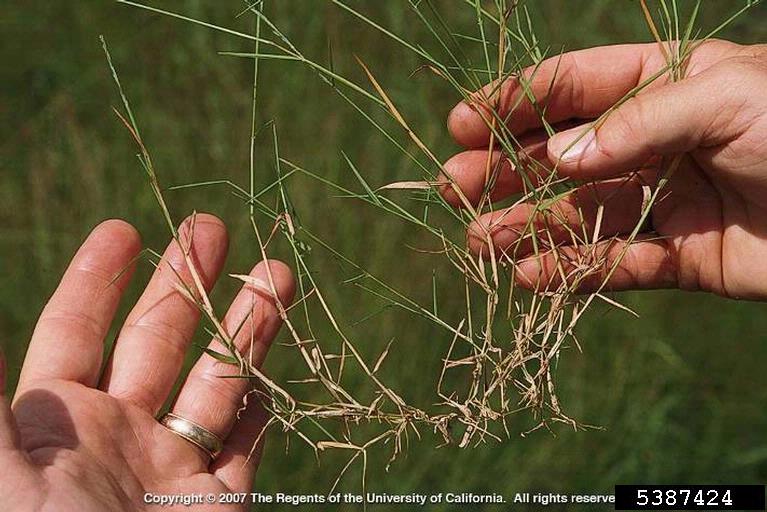
Perennial grasses, such as nimblewill, quackgrass, and windmillgrass, are some of the most difficult to control weeds in the lawn. Last summer's drought had thinned many lawns, opening up areas for weedy grasses to take hold.
 Nimblewill, Muhlenbergia schreberi, is a native, warm season, weedy grass that often invades home lawns. Nimblewill is a thin, wiry, pale green grass. The leaf blades are short and emerge at 45 degrees angles from the stems, which are slender, smooth and tend to lie flat on the ground. It spreads by short stolons, or above ground stems, that root at the nodes. Nimblewill forms circular patches as a result of its stoloniferous growth pattern, which grow larger each year. Pictured here are the long stringy nimblewill stems; image by Joseph M. DiTomaso, University of California - Davis, Bugwood.org.
Nimblewill, Muhlenbergia schreberi, is a native, warm season, weedy grass that often invades home lawns. Nimblewill is a thin, wiry, pale green grass. The leaf blades are short and emerge at 45 degrees angles from the stems, which are slender, smooth and tend to lie flat on the ground. It spreads by short stolons, or above ground stems, that root at the nodes. Nimblewill forms circular patches as a result of its stoloniferous growth pattern, which grow larger each year. Pictured here are the long stringy nimblewill stems; image by Joseph M. DiTomaso, University of California - Davis, Bugwood.org.
It grows best during the warmest summer months and can often be found in damp, shady areas or in areas that receive only a partial day of full sun. It is objectionable in cool season turfs like Kentucky bluegrass and tall fescue because of its delayed green up in the spring and early fall dormancy. Many homeowners also dislike the fine-bladed texture of nimblewill and its habit to lie very flat on the ground, making it difficult to mow.
Quackgrass, Elymus repens, is a European native, cool-season grass that has become naturalized throughout Nebraska. It prefers to grow in moist areas of the lawn, but can survive well in dry areas once established, becoming a serious invasive weed. It spreads through an aggressive rhizomatous root system, choking out more desirable grasses. The leaf blades are flat and thin, with few hairs, and no noticeable ridges or folds.
Windmill grass, Chloris verticillata, is a native, warm-season bunchgrass. It is found throughout Nebraska, but is most common the eastern and southern parts of the state. It grows in all types of soil, and is common in lawns. As a warm-season grass it begins growth late in spring, but grow and seeds quickly during the summer from May through September. As a bunchgrass, it spreads primarily through seeds. Plants have coarse, light green leaves and produce seedheads at a short height, becoming unsightly in a mowed lawn. The seedheads consist of 6-20 spike-like branches attached to a central axis, which resemble small tumbleweeds and can roll across the lawn in fall dispersing seeds.
Control
Nimblewill and windmillgrass can be controlled selectively with the herbicide Tenacity (mesotrione). Several applications, usually at least 3, should be made on 3-4 week intervals when the grass is green and actively growing for the best control. Susceptible grasses will turn white following the application, as chlorophyll in their leaves breaks down. Tenacity is labeled for use on Kentucky bluegrass, tall fescue, fine fescue, perennial ryegrass, and buffalograss. It should not be used on zoysiagrass unless damage or grass death can be tolerated. Tenacity can be applied by commercial pesticide applicators, or purchased online by homeowners.
Quackgrass is more difficult to control since there are no herbicides to selectively kill it without damaging the lawn. Also, pulling or digging is often unsuccessful since only a small portion of rhizome remaining in the soil is needed to generate a new plant. So the best way to control quackgrass, is to spot treat the weed-infested areas with glyphosate (Roundup, Kleenup, etc.).
Glyphosate is a systemic, non-selective herbicide. Glyphosate is absorbed through the foliage and is then translocated to all plant parts. It kills nearly all plants that are directly sprayed. Visible symptoms usually develop in 7 to 10 days of the application. Death occurs in 2 to 4 weeks.
Always read and follow all label directions when using any pesticide.
Efforts to control undesirable perennial grasses in the lawn should begin in mid-summer. This allows adequate time to kill the weedy grasses, then prepare the areas for seeding or sodding in late summer. Complete destruction of the weeds is necessary to prevent their reappearance. If the treated areas are not dead in 2 to 4 weeks, a second application is necessary. Treated areas can be seeded or sodded 7 days after application.
If you plan to sow seed, it's not necessary to dig up the destroyed areas. Vigorously rake these areas with a stiff tined garden rake to remove some of the dead debris and to break the soil surface. After seeding, work the seed into the soil by lightly raking the area and keep the soil moist with frequent, light applications of water. The best time to seed bare spots is mid-August through September. If you plan to sod, remove the dead debris before laying the sod.
The establishment of a thick, healthy lawn and its proper maintenance will help prevent future weed infestations.